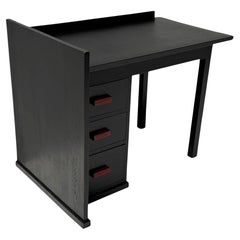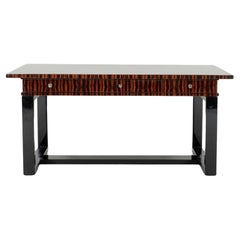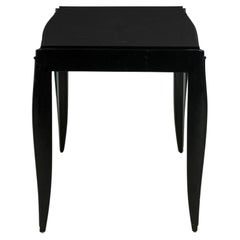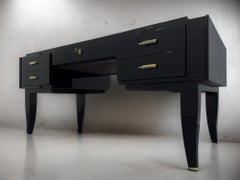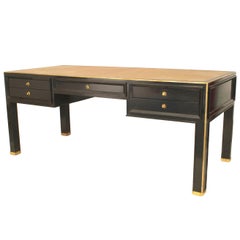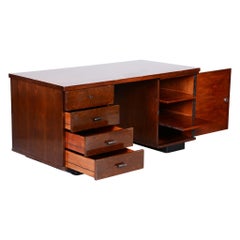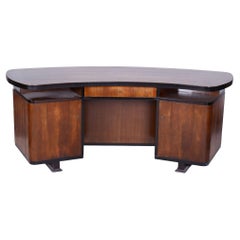Art Deco Lacquer Writing Desks
Vintage 1930s Dutch Art Deco Desks and Writing Tables
Oak
20th Century Art Deco Desks and Writing Tables
Nickel
20th Century French Art Deco Desks and Writing Tables
Wood, Lacquer
Vintage 1930s French Art Deco Desks and Writing Tables
Brass
Vintage 1920s Czech Art Deco Desks and Writing Tables
Lacquer, Wood, Mahogany, Walnut
20th Century French Art Deco Desks and Writing Tables
Brass
Vintage 1940s French Art Deco Desks and Writing Tables
Brass
20th Century Czech Art Deco Desks and Writing Tables
Oak, Lacquer, Walnut
Early 20th Century Czech Art Deco Desks and Writing Tables
Lacquer, Wood, Walnut
Vintage 1950s French Art Deco Desks and Writing Tables
Metal
Early 20th Century Czech Art Deco Desks and Writing Tables
Oak, Lacquer
Vintage 1930s Czech Art Deco Desks and Writing Tables
Steel, Chrome
Vintage 1930s Czech Art Deco Desks and Writing Tables
Brass
Early 20th Century Czech Art Deco Desks and Writing Tables
Chrome
Vintage 1930s American Art Deco Desks and Writing Tables
Aluminum
Vintage 1930s French Art Deco Desks and Writing Tables
Metal
Vintage 1930s French Art Deco Desks and Writing Tables
Opaline Glass, Wood, Lacquer, Rosewood
Vintage 1920s Dutch Art Deco Desks and Writing Tables
Oak
Vintage 1930s Belgian Art Deco Desks and Writing Tables
Oak
Vintage 1930s French Art Deco Desks and Writing Tables
Rosewood
2010s Philippine Art Deco Desks and Writing Tables
Rattan
Vintage 1920s French Art Deco Desks and Writing Tables
Wood
Vintage 1920s French Art Deco Desks and Writing Tables
Wood
Vintage 1930s Desks and Writing Tables
Aluminum, Chrome
Early 20th Century Art Deco Desks and Writing Tables
Brass
Vintage 1930s French Art Deco Desks and Writing Tables
Wood, Ebony, Zebra Wood
Vintage 1930s French Art Deco Desks and Writing Tables
Wood
Vintage 1920s French Art Deco Desks and Writing Tables
Chrome
Vintage 1930s American Art Deco Desks and Writing Tables
Chrome
Vintage 1920s Dutch Art Deco Desks and Writing Tables
Macassar, Walnut
2010s German Art Deco Desks and Writing Tables
Steel
2010s German Art Deco Desks and Writing Tables
Metal
2010s German Art Deco Desks and Writing Tables
Metal
Vintage 1930s Czech Art Deco Desks and Writing Tables
Wood, Walnut, Lacquer
Early 20th Century French Art Deco Desks and Writing Tables
Stainless Steel
Vintage 1920s French Art Deco Desks and Writing Tables
Bronze
Vintage 1940s French Art Deco Desks and Writing Tables
Brass
Vintage 1920s German Art Deco Desks and Writing Tables
Maple
Vintage 1930s French Art Deco Desks and Writing Tables
Wood
2010s American Modern Desks and Writing Tables
Bronze
Vintage 1940s French Art Deco Desks and Writing Tables
Bakelite, Wood
Vintage 1920s French Art Deco Desks and Writing Tables
Brass, Bronze
Vintage 1940s American Mid-Century Modern Desks and Writing Tables
Brass
Vintage 1930s French Art Deco Desks and Writing Tables
Wood
Mid-20th Century American Hollywood Regency Desks and Writing Tables
Brass
Vintage 1920s Italian Art Deco Desks and Writing Tables
Wood
Vintage 1920s French Art Deco Desks and Writing Tables
Macassar
20th Century French Art Deco Desks
Metal
Vintage 1940s French Art Deco Desks and Writing Tables
Chrome
Vintage 1950s Mid-Century Modern Desks and Writing Tables
Brass
2010s German Desks and Writing Tables
Poplar
20th Century French Art Deco Desks
Brass
Vintage 1930s French Bauhaus Desks and Writing Tables
Steel, Chrome
Vintage 1950s North American Mid-Century Modern Desks and Writing Tables
Brass
Mid-20th Century American Art Deco Desks
Wood
Vintage 1930s Swedish Scandinavian Modern Desks and Writing Tables
Birch, Macassar
Late 20th Century French Art Deco Desk Sets
Gold Plate, Enamel
Vintage 1940s American Art Deco Desks
Metal
- 1
Art Deco Lacquer Writing Desks For Sale on 1stDibs
How Much are Art Deco Lacquer Writing Desks?
A Close Look at Art Deco Furniture
Art Deco furniture is characterized by its celebration of modern life. More than its emphasis on natural wood grains and focus on traditional craftsmanship, vintage Art Deco dining chairs, tables, desks, cabinets and other furniture — which typically refers to pieces produced during the 1920s and 1930s — is an ode to the glamour of the “Roaring Twenties.”
ORIGINS OF ART DECO FURNITURE DESIGN
- Emerged in the 1920s
- Flourished while the popularity of Art Nouveau declined
- Term derives from 1925’s Exposition Internationale des Arts Décoratifs et Industriels Modernes (International Exhibition of Modern Decorative and Industrial Arts) in Paris, France
- Informed by Ancient Egypt, Cubism, Futurism, Louis XVI, De Stijl, modernism and the Vienna Secession; influenced Streamline Moderne and mid-century modernism
CHARACTERISTICS OF ART DECO FURNITURE DESIGN
- Bold geometric lines and forms, floral motifs
- Use of expensive materials such as shagreen or marble as well as exotic woods such as mahogany, ebony and zebra wood
- Metal accents, shimmering mirrored finishes
- Embellishments made from exotic animal hides, inlays of mother-of-pearl or ivory
ART DECO FURNITURE DESIGNERS TO KNOW
VINTAGE ART DECO FURNITURE ON 1STDIBS
Few design styles are as universally recognized and appreciated as Art Deco. The term alone conjures visions of the Roaring Twenties, Machine Age metropolises, vast ocean liners, sleek typography and Prohibition-era hedonism. The iconic movement made an indelible mark on all fields of design throughout the 1920s and ’30s, celebrating society’s growing industrialization with refined elegance and stunning craftsmanship.
Widely known designers associated with the Art Deco style include Émile-Jacques Ruhlmann, Eileen Gray, Maurice Dufrêne, Paul Follot and Jules Leleu.
The term Art Deco derives from the name of a large decorative arts exhibition held in Paris in 1925. “Art Deco design” is often used broadly, to describe the work of creators in associated or ancillary styles. This is particularly true of American Art Deco, which is also called Streamline Moderne or Machine Age design. (Streamline Moderne, sometimes known as Art Moderne, was a phenomenon largely of the 1930s, post–Art Nouveau.)
Art Deco textile designers employed dazzling floral motifs and vivid colors, and while Art Deco furniture makers respected the dark woods and modern metals with which they worked, they frequently incorporated decorative embellishments such as exotic animal hides as well as veneers in their seating, case pieces, living room sets and bedroom furniture.
From mother-of-pearl inlaid vitrines to chrome aviator chairs, bold and inventive works in the Art Deco style include chaise longues (also known as chaise lounges) and curved armchairs. Today, the style is still favored by interior designers looking to infuse a home with an air of luxury and sophistication.
The vintage Art Deco furniture for sale on 1stDibs includes dressers, coffee tables, decorative objects and more.
Finding the Right Desks-writing-tables for You
Choosing the perfect writing desk or writing table is a profoundly personal journey, one that people have been embarking upon for centuries.
Queen Atossa of Persia, from her writing table circa 500 B.C., is said to have been the originator of the art of handwritten letters. Hers was reportedly the first in a long and colorful history of penned correspondence that grew in popularity alongside literacy. The demand for suitable writing desks, which would serve the composer of the letters as well as ensure the comfort of the recipient naturally followed, and the design of these necessary furnishings has evolved throughout history.
Once people began to seek freedom from the outwardly ornate styles of the walnut and rosewood writing desks and drafting tables introduced in the name of Queen Victoria and King Louis XV, radical shifts occurred, such as those that materialized during the Art Nouveau period, when designers longed to produce furniture inspired by the natural world’s beauty. A prime example is the work of the famous late-19th-century Spanish architect Antoni Gaudí — his rolltop desk featured deep side drawers and was adorned with carved motifs that paid tribute to nature. Gaudí regularly combined structural precision with decorative elements, creating beautiful pieces of furniture in wood and metal.
Soon afterward, preferences for sleek, geometric, stylized forms in furniture that saw an emphasis on natural wood grains and traditional craftsmanship took hold. Today, Art Deco desks are still favored by designers who seek to infuse interiors with an air of luxury. One of the most prominent figures of the Art Deco movement was French decorator and furniture designer Émile-Jacques Ruhlmann. With his use of neoclassical motifs as well as expensive and exotic materials such as imported dark woods and inlays of precious metals for his writing desks, Ruhlmann came to symbolize good taste and modernity.
The rise in appreciation for Scandinavian modernism continues to influence the design of contemporary writing desks. It employs the “no fuss” or “less is more” approach to creating a tasteful, sophisticated space. Sweden’s master cabinetmaker Bruno Mathsson created gallery-worthy designs that are as functional as they are beautiful. Finnish architect Alvar Aalto never viewed himself as an artist, but, like Mathsson, his furniture designs reflected a fondness for organic materials and a humanistic approach. Danish designers such as Hans Wegner introduced elegant shapes and lines to mid-century desks and writing tables, often working in oak and solid teak.
From vintage desks to contemporary styles, 1stDibs offers a broad spectrum of choices for conducting all personal and business writing and reading activities.
